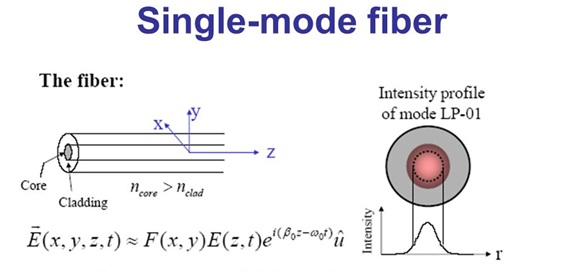- Related articles
- All Cisco DS-X2-FC10G-SR's information (List price, Specs, Datasheet PDF, Compatibility ma
- How to Set up Network Card?
- What is a transceiver module?
- Optical Transceivers for Cisco N3K-C3132Q-XL Switch
- Applicable to 1000BASE-T Standard optical transceiver models
- Optical Transceivers for Cisco SG350XG-2F10-K9-UK Switch
- The difference between XENPAK and XFP
- Optical Transceivers for Cisco WS-C2960X-24TD-L Switch
- Optical Transceivers for Cisco SM-D-ES3G-48-P= Switch
- Optical Transceivers for Cisco WS-C3650-24PS-L Switch

Definition
Single-mode optical fiber (SMF) is an optical fiber designed to carry light only directly down the fiber - the transverse mode. Modes are the possible solutions of the Helmholtz equation for waves, which is obtained by combining Maxwell's equations and the boundary conditions. These modes define the way the wave travels through space, i.e. how the wave is distributed in space. Waves can have the same mode but have different frequencies. This is the case in single-mode fibres, where we can have waves with different frequencies, but of the same mode, which means that they are distributed in space in the same way, and that gives us a single ray of light.
Since there is only one mode, there is no problem with modal dispersion and the choice of core material can reduce chromatic dispersion (see below) which increases the bandwidth to almost infinity - but it's practically limited to about 100,000 gigahertz - that's still a lot! Single mode fiber has a core diameter of 8-10 microns, specified as "mode field diameter," the effective size of the core, and a cladding diameter of 125 microns.
Application
Single mode fiber is commonly used for high-speed, long-distance application. They are used by many telecommunications companies to transmit telephone signals, Internet communication, and cable television signals. Due to much lower attenuation and interference, Single mode fiber has large advantages over existing copper wire in long-distance and high-demand applications.
Single mode fiber types:
There are several designations used to describe various types of SM fiber that are often confusing. Here are the ones in common use today.
|
Description |
IEC SMF Type |
ITU Spec |
TIA Spec |
|
Standard Single mode Fiber |
B1.1 |
G.652 |
TIA 492CAAA / OS1 |
|
Cutoff Shifted Fiber |
B1.2 |
G.654 |
|
|
Low Water Peak Fiber |
B1.3 |
G.652 |
TIA 492CAAB / OS2 |
|
Dispersion Shifted Fiber |
B2 |
G.653 |
|
|
Non-Zero Dispersion Shifted Fiber |
B4 |
G.655 |
TIA-492E000 / TIA-492EA00 |
|
Bend-Insensitive Fiber |
|
G .657 |
|
Single mode VS Multi-mode fiber
Single mode fiber has a small light carrying core of 8 to 10 microns in diameter. It is normally used for long distance transmissions with laser diode based fiber optic transmission equipment. Multimode fiber has a relatively large light carrying core, usually 62.5 microns or larger in diameter. It is usually used for short distance transmissions with LED based fiber optic equipment.
History
In 1961, Elias Snitzerwhile working at American Optical published a comprehensive theoretical description of single mode fibers in the Journal of the Optical Society of America.
At the Corning Glass Works (now Corning Inc.), Robert Maurer, Donald Keck and Peter Schultz started with fused silica, a material that can be made extremely pure, but has a high melting point and a low refractive index. They made cylindrical preforms by depositing purified materials from the vapor phase, adding carefully controlled levels of dopants to make the refractive index of the core slightly higher than that of the cladding, without raising attenuation dramatically. In September 1970, they announced they had made single-mode fibers with attenuation at the 633-nanometer helium-neon line below 20 dB/km.
HOW DOES FIBER OPTICS WORK?
As explained by the Fiber Optics Association, fiber optics is the communications medium that sends optical signals down hair-thin strands of extremely pure glass cores. The core is surrounded by the cladding that traps the light in the core.
Single Mode Fiber Types: OS1 vs OS2
As we all know, multimode fiber is usually divided intoOM1, OM2, OM3, OM4 and OM5fiber types. When it comes to single mode fiber types, it can be categorized into OS1 and OS2 fiber, which are SMF fiber specifications.
OS1 fiber is mainly used in the construction of indoor applications, such as campus networks and building networks, where the maximum distance is 10 km. OS2 fiber is more suitable for outdoor applications including backhaul networks, external plants, FTTH, WDM/DWDM network, etc., where the maximum distance is up to 200 km.
OS1 vs OS2: What are Their Differences?
It’s of great significance to figure out the difference between OS1 and OS2 when conducting deployments. The specification table below will present the differences between them clearly.
| OS1 | OS2 | |
|---|---|---|
| Standards | ITU-T G.652A/B/C/D | ITU-T G.652C/G.657.A1 (part) |
| Cable Construction | Tight Buffer | Loose Tube |
| Application | Indoor | Outdoor |
| Attenuation | 1.0db/km | 0.4db/km |
| Max. Distance | 10 km | 200 km |
| Price | Low | High |
Advantages:
-
No degradation of signal
-
Low dispersion
-
Good suitability for long distance communication
Disadvantages:
-
More difficult manufacturing and handling
-
Higher price
-
Difficult coupling of light into the fiber
Conclusion
The optical communication is now coming into its own and is becoming the preferred technology for many applications. In this way, integrated electronic circuits have defined the 20th century as the century of electronics, whilst the 21st century is emerging as the century of optoelectronics – as a result of light wave technology. The success of this evolution will lead to the development of new optoelectronic devices, a field where innovations are progressing at "light velocity".
Please click to check more related concepts:
| Type of fiber mode |
Multi-mode |






































































